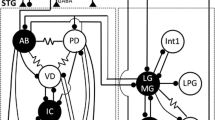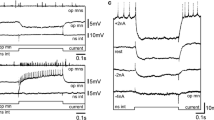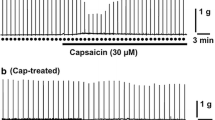Summary
In the higher Decapoda Crustacea a small inferior ventricular nerve (ivn) directly connects the supra-oesophageal ganglion (S.O.G.) with the stomatogastric nervous system. Collision experiments (Fig. 3) in the isolated preparation of the stomatogastric nervous system ofPanulirus argus demonstrated that two fibres (ivn through fibres) pass directly from the ivn to the stomatogastric nerve (sgn). The sgn is considered to be the sole input pathway to the stomatogastric ganglion.
The 28–30 neurones of the stomatogastric ganglion (St. G.) form a motor relay station which directly controls much of the activity of the foregut in these animals. The stomatogastric neurones form two distinct groups. One of these groups controls the activity of the gastric mill (gastric mill cycle) and the other group controls the activity of the pyloric stomach filtering apparatus (pyloric cycle). The mechanism of formation of the pyloric cycle is intrinsic to the St. G. and apparently normal pyloric cycle activity is recorded in the isolated preparation. The situation with regard to the gastric mill cycle is less clear and normal activity was not recorded in our isolated preparations.
Stimulation of the ivn selectively activated the two through fibres in the sgn and produced marked frequency-dependent changes in the output of both groups of stomatogastric ganglion neurones (Table 1). The ivn through fibres are therefore regarded as command fibres. The effects of the two fibres were indistinguishable and additive when both fibres were stimulated simultaneously. Low frequency stimulation of the ivn (Figs. 4, 5) produced increased pyloric cycle frequency with more pronounced activity in the dilator group of neurones (PD, VD, AB). Higher frequency stimulation (5–10 per second) effectively disrupted the pyloric cycle (Figs. 6, 7), and at 20 per second almost all activity ceased. Only the activity of the GM neurones of the gastric cycle was examined. These neurones were relatively unaffected by low frequency stimulation but were progressively inhibited by higher frequency stimulation (Fig. 8) and at 20 per second they were subject to rapid, total and sustained inhibition.
The mechanisms producing these changes were investigated by intracellular recordings from identified neurones of the St. G. In the pyloric cycle at least the PD pacemaker and the VD neurones of the dilator group received direct epsps from the command fibres (Figs. 11–14). The antagonistic pyloric constrictor elements (PY) were subject to increased indirect inhibition from the more active dilator neurones and in some cases there was probably also direct inhibition of these constrictor neurones (Figs. 9, 10). The GM neurones received a possible direct ipsp and at least one indirect effect by an increase in an ongoing ipsp during stimulation (Figs. 15, 16). There was little facilitation of the command ipsps at the frequencies used but at higher frequencies there was a summation which produced strong hyperpolarization. The innervation pattern of the ivn command fibres in the St. G. is summarized in Fig. 17.
The ivn through fibres have very strong direct effects. The weight of present evidence is that in this system most presynaptic fibres have much smaller modulating effects. The function of the ivn through fibres is unknown at this time.
Similar content being viewed by others
References
Arvanitaki, A., Chalazonitis, N.: Electrical properties and temporal organisation in oscillatory neurones. In: Neurobiology of invertebrates, ed. J. Salanki. New York: Plenum Press 1968.
Atwood, H. L., Wiersma, C. A. G.: Command interneurones in the crayfish central nervous system. J. exp. Biol.46, 249–261 (1967).
Balss, H.: Crustacea, Decapoda. In: Klassen und Ordnungen des Tierreichs, Bd. 5, Abt. 7, Buch 7, Hrsg. H. C. Bronn. Leipzig: Akademische Verlagsgesellschaft 1961.
Blankenship, J. E., Wachtel, H., Kandel, E. R.: Ionic mechanisms of excitatory, inhibitory, and dual synaptic actions mediated by an identified interneurone in abdominal ganglion ofAplysia. J. Neurophysiol.34, 76–92 (1971).
Bullock, T. H., Horridge, G. A.: Structure and function in the nervous systems of invertebrates, vol. 2. San Francisco: W. H. Freeman & Co. 1965.
Hagiwara, H.: Nervous activities of the heart in Crustacea. Ergebn. Biol.24, 287–311 (1961).
Kandel, E. R., Frazier, W. T., Waziri, R., Coggeshall, R. E.: Direct and common connections among identified neurones inAplysia. J. Neurophysiol.30, 1352–1376 (1967).
Kandel, E. R., Wachtel, H.: The functional organisation of neural aggregates inAplysia. In: Physiological and biochemical aspects of neural integration, ed. F. D. Carlson. New Jersey: Prentice-Hall 1968.
Kandel, E. R., Kupferman, I.: The functional organisation of invertebrate ganglia. Ann. Rev. Physiol.30 193–258 (1970).
Katz, B.: Nerve, muscle and synapse, p. 155–156. New York: McGraw-Hill 1966.
Kennedy, D.: Crayfish interneurones. Physiologist14, 5–30 (1971).
Larimer, J. L., Kennedy, D.: Visceral afferent signals in the crayfish stomatogastric ganglion. J. exp. Biol.44, 345–354 (1966).
Maynard, D. M.: In: The interneurone, p. 58–70, ed. MaryA. B. Brazier. Los Angeles: University of California Press 1969.
Maynard, D. M.: Simpler networks. Conference on patterns of integration. New York: Academy of Sciences 1971.
Maynard, D. M., Burke, W.: Electrotonic junctions and negative feedback in the stomatogastric ganglion of the mud crab,Scylla serrata. Amer. Zool.6, 526 (1966).
Maynard, D. M., Dando, M. R.: In preparation.
Maynard, E. A.: Electron microscopy of stomatogastric ganglion in the lobsterHomarus americanus. Tissue and Cell,3, 137–160 (1971).
Mendelsohn, M.: Oscillator neurones in crustacean ganglia. Science171, 1170–1173 (1971).
Miller, P. L.: The derivation of the motor command to the spiracles of the locust. J. exp. Biol.46, 349–372 (1967).
Morris, J., Maynard, D. M.: Recordings from the stomatogastric nervous system in intact lobsters. Comp. Biochem. Physiol.33, 969–974 (1970).
Orlov, J.: Über den histologischen Bau der Ganglien des Mundmagennervensystems der Crustaceen. Z. mikr.-anat. Forsch.8, 493–541 (1929).
Sandeman, D. C.: The excitation and electrical coupling of four identified motoneurons in the brain of the australian mud crab,Scylla serrata. Z. vergl. Physiol.72, 111–130 (1971).
Watanabe, A., Obara, S., Akiyama, T.: Inhibitory synapses on pacemaker neurons in the heart ganglion of a stomatopod,Squilla oratona. J. gen. Physiol.52, 908–924 (1968).
Watanabe, A., Obara, S., Akiyama, T.: Acceleratory synapses on pacemaker neurons in the heart ganglion of a stomatopod,Squilla oratona. J. gen. Physiol.54, 212–231 (1969).
Wilson, D. M.: Neural operations in arthropod ganglia. In: The neurosciences; a second study program, ed. F. O. Schmitt. New York: Rockefeller University Press 1970.
Author information
Authors and Affiliations
Additional information
Contribution No. 531 from the Bermuda Biological Station, St. Georges West, Bermuda.
Supported by USPHS Grant Nos. NS-06017-05 and NS-09471-01 to Dr. D. M. Maynard and NS-09322-01 to Dr. A. I. Selverston.
We would like to thank Dr. D. M. Maynard for introducing us to the stomatogastric ganglion preparation. We would also like to thank Drs. B. Mulloney and D. Kennedy for critical reading of the manuscript.
Rights and permissions
About this article
Cite this article
Dando, M.R., Selverston, A.I. Command fibres from the supra-oesophageal ganglion to the stomatogastric ganglion inPanulirus argus . J. Comp. Physiol. 78, 138–175 (1972). https://doi.org/10.1007/BF00693610
Received:
Issue Date:
DOI: https://doi.org/10.1007/BF00693610




